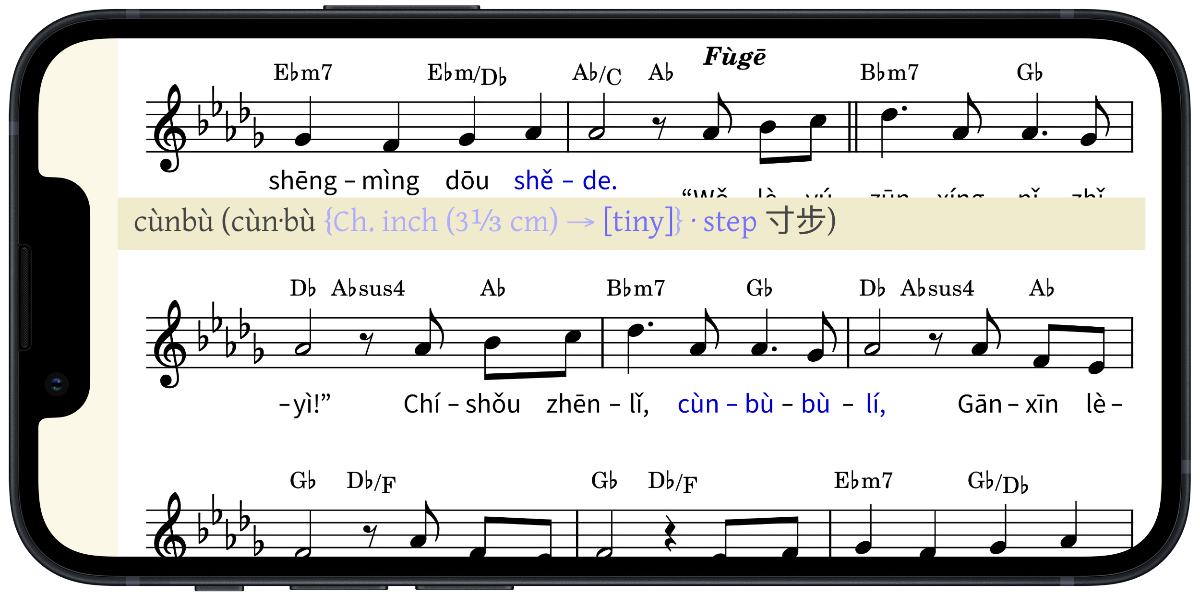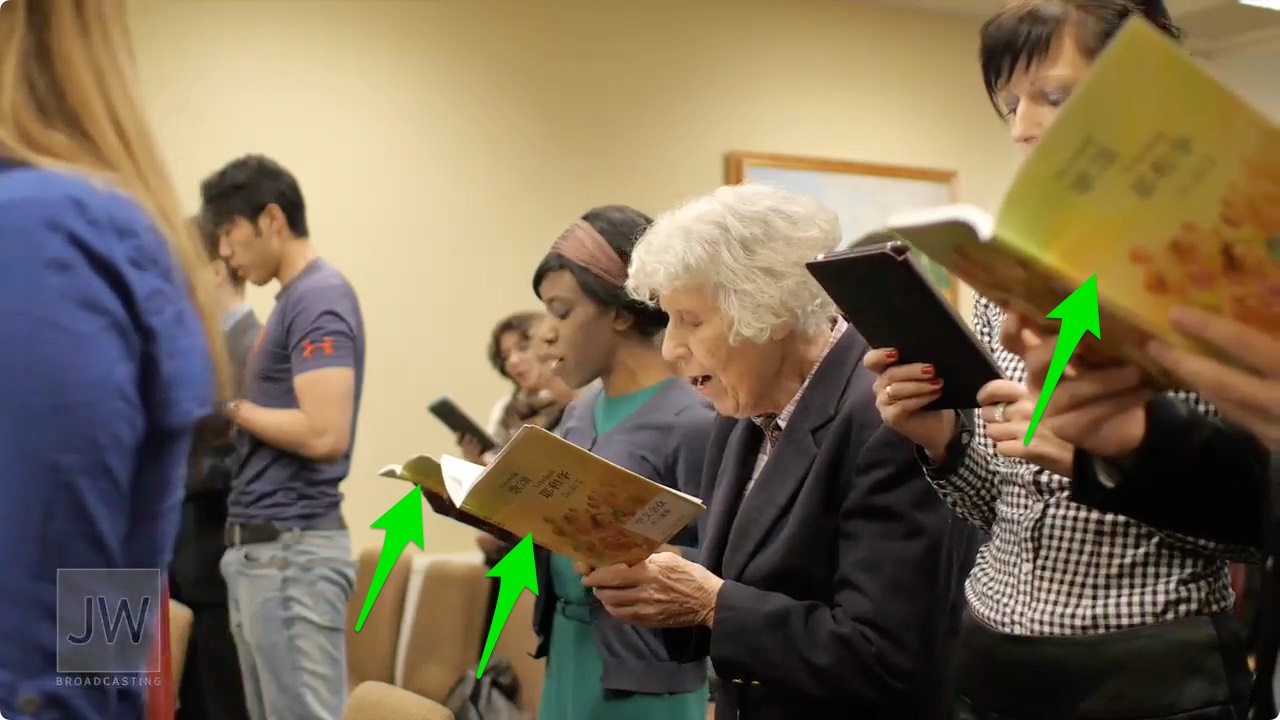cùnbù (cùn·bù {Ch. inch (3⅓ cm) → [tiny]} · step 寸步)‐bù (not 不)‐lí (leave; {part/depart [from]}; {[is] away/apart/distant/far apart from} 离 離/离) 👈🏼 Tap/click to show/hide the “flashcard”
[Notes: Tap/click on a Pīnyīn (Pīn·yīn {Piecing Together of} · Sounds → [Pinyin] 拼音) expression to reveal its “flashcard”; tap/click on a “flashcard” or its Pīnyīn (Pīn·yīn {Piecing Together of} · Sounds → [Pinyin] 拼音) expression to hide the “flashcard”. 📖 📄 📘 icons mean 📖 Reveal All, 📄 Reveal Advanced, and 📘 Reveal None re all the “flashcards” in the heading, paragraph, etc. that they are placed at the beginning of.]
Rather than dismissively thinking to ourselves that the songs produced by the organization are “just songs”, we should remember that the slave class takes seriously its responsibility to provide spiritual food to God’s people, and so it is going to make sure that the lyrics in its songs are spiritually correct, while also being emotionally moving.—Ezekiel 33:32; Matthew 24:45.
Not Deviating an Inch

This week’s MEotW in the unofficial Pīnyīn (Pīn·yīn {Piecing Together of} · Sounds → [Pinyin] 拼音) Plus resource “Sing Out Joyfully” Bk. (Pīnyīn+Music, Pīnyīn Plus, Web)
This week’s MEotW, “cùnbù (cùn·bù {Ch. inch (3⅓ cm) → [tiny]} · step 寸步)‐bù (not 不)‐lí (leave; {part/depart [from]}; {[is] away/apart/distant/far apart from} 离 離/离)”, comes from the chorus of song 161, which is entitled “To Do Your Will Is My Delight” in English and “Wǒ (I 我) Lèyú (Lè·yú {Am Happy} · to 乐于 樂於) Zūnxíng (Zūn·xíng {Abide by} · {Walk → [Do]} 遵行) Nǐ de ((Nǐ You 你) (de ’s 的) → [Your]) Zhǐyì (Zhǐ·yì Will · {Meaning → [Will]} → [Will] 旨意)” in Mandarin:
To do your will is my delight.
I give you all my strength and might.
This joy I feel; this joy is real.
I will walk on in your light.
Mandarin (WOL, Pīnyīn (Pīn·yīn {Piecing Together of} · Sounds → [Pinyin] 拼音) Plus):
📖 📄 📘 “Wǒ (I 我) lèyú (lè·yú {am happy} · to 乐于 樂於) zūnxíng (zūn·xíng {abide by} · {walk → [do]} 遵行) nǐ (your 你) zhǐyì (zhǐ·yì will · {meaning → [will]} → [will] 旨意)!”
Chíshǒu (Chí·shǒu {to hold → [to support]} · {to defend → [to abide by]} → [to hold fast to] 持守) zhēnlǐ (zhēn·lǐ true · reasoning → [the truth] 真理), cùnbù (cùn·bù {Ch. inch (3⅓ cm) → [tiny]} · step 寸步)‐bù (not 不)‐lí ({to depart} 离 離/离),
Gānxīn (Gān·xīn {to be (of) sweet → [to be of willing]} · heart → [to be willing] 甘心) lèyì (lè·yì {to be (of) happy} · {meaning → [intention]} → [to be willing] 乐意 樂意), wúwèi (wú·wèi {to be without} · {fearing of} 无畏 無畏) jiānxīn (jiān·xīn {(things being) arduous} · {(things being) hot (in taste) → [(things being) hard]} → [hardships] 艰辛 艱辛),
Jìn ({to expend to the limit} 尽 盡) quánlì (quán·lì whole · strength 全力), zài‐suǒ‐bùxī ((zài in 在)‐(suǒ place 所)‐(bù·xī not · {to cherish → [to stint]} 不惜) → [not to balk]).
While not being a direct translation, “Chíshǒu (Chí·shǒu {to hold → [to support]} · {to defend → [to abide by]} → [to hold fast to] 持守) zhēnlǐ (zhēn·lǐ true · reasoning → [the truth] 真理), cùnbù (cùn·bù {Ch. inch (3⅓ cm) → [tiny]} · step 寸步)‐bù (not 不)‐lí ({to depart} 离 離/离)” seems to correspond with “I will walk on in your light” in the above example. For those who are interested, a more literal translation of “Chíshǒu (Chí·shǒu {to hold → [to support]} · {to defend → [to abide by]} → [to hold fast to] 持守) zhēnlǐ (zhēn·lǐ true · reasoning → [the truth] 真理), cùnbù (cùn·bù {Ch. inch (3⅓ cm) → [tiny]} · step 寸步)‐bù (not 不)‐lí ({to depart} 离 離/离)” would be “to hold fast to the truth, (even) a step of an inch not to depart (from it)”. To get even further into the weeds, while the expression “cùn ({Ch. inch (3⅓ cm)} [→ [inch | very little/short; small; tiny]] 寸)” that is used above is now often used to mean the British Imperial inch (2.54 cm), it actually originally referred to the Chinese inch (3⅓ cm). Either way, a “cùnbù (cùn·bù {Ch. inch (3⅓ cm) → [tiny]} · step 寸步)” is a tiny step indeed.
Regarding the other morphemes in “cùnbù (cùn·bù {Ch. inch (3⅓ cm) → [tiny]} · step 寸步)‐bù (not 不)‐lí (leave; {part/depart [from]}; {[is] away/apart/distant/far apart from} 离 離/离)”, it may be helpful to note that the “bù” (step; pace (v or n) [→ [condition; situation; state]] 步) in “cùnbù” (cùn·bù {Ch. inch (3⅓ cm) → [tiny]} · step 寸步) also appears in the well-known expressions “bùzhòu” (bù·zhòu step · {to be trotted} → [step; move; measure; phase] 步骤 步驟) and “jìnbù (jìn·bù {advancing [of]} · steps → [progress[ing]; advancing; improvement] 进步 進步)”, and that this “lí” (leave; {part from}; {[is] away/apart/distant/far apart from} 离 離/离) is the one in “líkāi (lí·kāi leave · {to be opened [from] → [away [from]; apart [from]; clear [of]]} 离开 離開).”
Musical Notation 🎼 and the Mandarin Field
In this post about a Mandarin expression found in our songbook, another subject that I want to touch on is: Is musical notation 🎼 too hard to be worth the trouble of producing it and using it? Are fewer and fewer people able to read it? I was fortunate enough to have been taught how to read musical notation in school. I have never thought of musical notation as being particularly difficult to use (it’s much easier to learn than characters, which many unquestioningly try to learn), and I find that it helps me to sing Kingdom songs more correctly (according to the intended melody, message, etc.) and more confidently more of the time. However, I am aware that not everyone in the Mandarin field has the same experience with musical notation. For example, a while ago, an older brother told me that he didn’t know how to read musical notation. Also, some people in the Mandarin field may have been affected by how education systems in this old world have been facing significant challenges relating to providing music education for younger ones.
Regardless of how the world may be failing in many cases to equitably provide good music education, Jehovah’s organization has pointed out that music is important in Jehovah’s worship. For example, not long ago, a Meeting Workbook said:
Music can have a powerful influence on the mind and body. Singing is an important part of our worship of Jehovah.
In accordance with the importance of music in Jehovah’s worship, Mandarin field language learners used to have available to them official material from the organization containing musical notation with Pīnyīn (Pīn·yīn {Piecing Together of} · Sounds → [Pinyin] 拼音) in the lyrics. However, perhaps at least partially because of the technical difficulty and costliness of producing material with musical notation and both Chinese characters and Pīnyīn (Pīn·yīn {Piecing Together of} · Sounds → [Pinyin] 拼音) in the lyrics, as of this writing, there is no official material currently available from the organization that shows Pīnyīn (Pīn·yīn {Piecing Together of} · Sounds → [Pinyin] 拼音) and musical notation on the same page or screen.

A screenshot from an official video, of Sis. Margarita Königer and others using official Pīnyīn (Pīn·yīn {Piecing Together of} · Sounds → [Pinyin] 拼音) Sing to Jehovah songbooks with musical notation
The organization continues to publish official songbook material for different languages in general that contains musical notation, so it evidently still considers musical notation to generally be worthwhile to produce. It continues to produce official material for the current songbook that uses musical notation along with lyrics rendered only in Chinese characters, without Pīnyīn (Pīn·yīn {Piecing Together of} · Sounds → [Pinyin] 拼音), and it has even produced official material that uses jiǎnpǔ (jiǎn·pǔ simple · {register or record for reference → [musical notation]} → [numbered musical notation] 简谱 簡譜) (a kind of musical notation also known as numbered musical notation) and Chinese characters.
For those who find it helpful in their Mandarin field activities to put musical notation together with Pīnyīn (Pīn·yīn {Piecing Together of} · Sounds → [Pinyin] 拼音), the unofficial Pīnyīn (Pīn·yīn {Piecing Together of} · Sounds → [Pinyin] 拼音) Plus resource “Sing Out Joyfully” Bk. (Pīnyīn+Music, Pīnyīn Plus, Web) exists and is continuing to be improved. As shown in the screenshot near the beginning of this post, this resource aids Mandarin field language learners by breaking with tradition and featuring lyrics in the musical notation that are only in relatively large-print Pīnyīn (Pīn·yīn {Piecing Together of} · Sounds → [Pinyin] 拼音) by default—characters are relegated to Pīnyīn (Pīn·yīn {Piecing Together of} · Sounds → [Pinyin] 拼音) Plus “flashcards” that are added as time allows.
Unlike the traditionally-used but unnecessarily extraordinarily complex characters that need to be accompanied by Pīnyīn (Pīn·yīn {Piecing Together of} · Sounds → [Pinyin] 拼音) before many are able to read them, Pīnyīn (Pīn·yīn {Piecing Together of} · Sounds → [Pinyin] 拼音) itself is a simple, elegant alphabetical full writing system for Mandarin that is easy to learn and remember. Also, it is no harder to typeset than other alphabetical writing systems with diacritics, such as the writing systems now used for French, Czech, Vietnamese, etc.*
In its Tips: section at the bottom of its home page, the “Sing Out Joyfully” Bk. (Pīnyīn+Music, Pīnyīn Plus, Web) resource contains these links that some may find helpful:
- Watchtower article about the “Sing Out Joyfully” book, with basic advice on how to improve our singing:
- Resources for learning how to read musical notation 🎼:
For convenience:
The direct link for the Pīnyīn (Pīn·yīn {Piecing Together of} · Sounds → [Pinyin] 拼音) Plus resource for the “Sing Out Joyfully” book is:
The short link for Chinese field language-learning links for the “Sing Out Joyfully” book is:
More Pīnyīn (Pīn·yīn {Piecing Together of} · Sounds → [Pinyin] 拼音) and Pīnyīn (Pīn·yīn {Piecing Together of} · Sounds → [Pinyin] 拼音) Plus web material based on the Mandarin “Sing Out Joyfully” book will be made available in the Pīnyīn (Pīn·yīn {Piecing Together of} · Sounds → [Pinyin] 拼音) Plus web resource as time allows.
* Thanks to ongoing advancements in personal computing hardware and software, producing material that contains things like musical notation and Pīnyīn (Pīn·yīn {Piecing Together of} · Sounds → [Pinyin] 拼音) text at reasonable cost is quicker and easier than ever. At this time, production of the musical notation in the “Sing Out Joyfully” Bk. (Pīnyīn+Music, Pīnyīn Plus, Web) resource begins in free open source software called MuseScore Studio, running on a Mac. Pīnyīn (Pīn·yīn {Piecing Together of} · Sounds → [Pinyin] 拼音) text for the lyrics in the musical notation is entered using macOS’s ABC – Extended input source (keyboard layout). (Just using Pīnyīn (Pīn·yīn {Piecing Together of} · Sounds → [Pinyin] 拼音) text only here simplifies things so much compared to having to somehow input characters with Pīnyīn (Pīn·yīn {Piecing Together of} · Sounds → [Pinyin] 拼音) ruby text!) When it’s ready, the musical notation for a song is exported from MuseScore Studio into SVG format, which is a plain text format that allows for the inclusion of links that activate Pīnyīn (Pīn·yīn {Piecing Together of} · Sounds → [Pinyin] 拼音) Plus flashcards on webpages. The coding for the SVG links is currently done using the text editor BBEdit, in which editing large text files is quite performant. For Pīnyīn (Pīn·yīn {Piecing Together of} · Sounds → [Pinyin] 拼音) Plus web material production in general, my current favourite tool is Nova, but such web material can be produced in any application suitable for web development, such as Visual Studio Code, etc. ^



